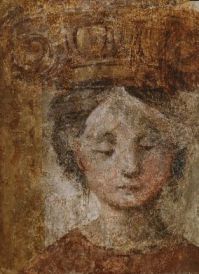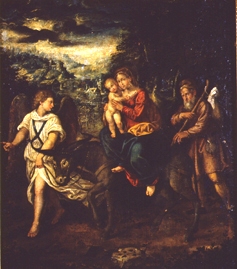Translation from the Italian by Michael S. Howard, June 2013
The life of an artist has always been subject to the tyranny of Fortune. Many famous and as many little known, sometimes extraordinarily so. In the first half of the sixteenth century lived Aurelio Busso (or Buso), one of the many on which the Fates did not smile, although of considerable talent - "despite his virtues" – so much so as to receive commendations from Raphael himself. Forced into destitution, towards the end of his life (he died probably in the early '60s of the sixteenth century), he was forced to live by decorating tarot cards.

Born into a family of painters, he attended the Accademia di San Luca in Rome, a pupil of Polidoro da Caravaggio and Maturino da Firenze. As a fresco painter, he specialized in the execution of friezes decorated with small stories, as we find in the rectory of the Cathedral of Crema. During his trips to the peninsula he frescoed palaces in Genoa, Venice and Milan as well in Crema. His Flight into Egypt. in the Tadini Gallery of Lovere, places him among the best painters of the time.

The Flight into Egypt
Oil on canvas
He also had several students, starting with Giovanni Battista Castello, called Bergamasco (grandson of Civerchio), who took him to Genoa, where he worked on the exterior decoration of some palaces for Giovanni Da Monte.
For his particular character, of a bohemian type, not properly administering the compensation handed out to him for his work and the fact of not having been able to create established friendships, at some point in his life he began to suffer from poverty. Aurelio Busso died in poverty, having led a dissolute life so as to be reduced, to get by, to decorating tarot cards.
In the work Marvels of art, or Lives of the Distinguished Painters of Venice and its State. Where are collected Their Famous Works, Customs, & Portraits. With the Narrative of the Histories, Legends, and Morality of those Painted, composed by Cavalier Carlo Ridolfi and published in Venice in 1648, the author reports briefly the life of Buso (1).
LIFE OF AURELIO BUSO
PAINTER
"He was a pupil of Polidoro da Caravaggio and Maturino, and served them in many works that they made in Rome, so that he often brought into his works the concepts of Raphael,and Giulio Romano.
The City of Crema enjoys the painting of that Author, in which the; in fresco in the Chapel of the Trinity and above the tower of torment, in the part that looks out on the square, some large figures in chiaroscuro, now poorly seen, being corroded by time.
In the Palace of the Signori Antonio Conti, and the brothers Benzoni, Venetian Patricans, he made in the frieze a room of many bodies of men, and women, and children, worthy of regard for their many noble shapes, with streamers & other ornaments, and in the room of Signor. Ranuccio Zorla he painted on a ceiling the Banquet of the Gods, and aspects of the same palace, in chiaroscuro.
The facade of the house of Signore Gambazzocchi, with the Rape of the Sabine Women also in chiaroscuro, was the work of this man, and his other pictures are in private homes.
In the Villa of Moschesano he painted, also in fresco, the casino of Count Ridolfo Vimercaro with histories & various fantasies. He died unhappy, despite his virtues, to live in a miserable state and gave himself, in order to live, to painting tarot cards".
Notes
1 - P. 406
Copyright by Andrea Vitali - © All rights reserved 2007